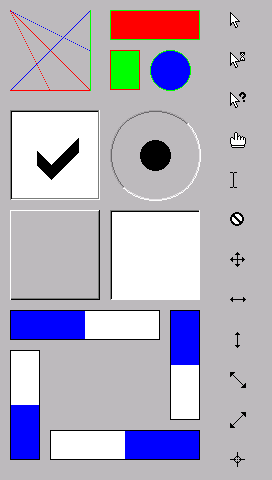M5P01_Prokaron
 M5P01_Prokaron copied to clipboard
M5P01_Prokaron copied to clipboard
A tiny real-time kernel focusing on formal reliability and simplicity.
One RTOS (RMP)
点击 这里 查看中文版。
RMP is a small real-time operating system which focuses on formal reliability and simplicity. It achieves reliability by deployment of formal techniques(not completed yet; only whitebox testing with 100% branch coverage done. The kernel can be regarded as pre-certified IEC 61508 SIL2, or EAL 4). All the basic functionalities that are necessary for RTOSes are provided, but nothing more. This guarantees that the system is the minimum possible kernel and is also suitable to be used as a guest operating system when hosted on virtual machine monitors.
This operating system is much leaner than any other RTOSes, especially when compared to FreeRTOS or RT-Thread, and understanding it should be simple enough. Yet it provides a complete set of functions that you may need during resource-constrained microcontroller development, such as efficient memory management, anti-aliasing graphics, and various helper functions. All these features come in a single .C file, and are without any extra RAM consumption!
The manual of the operating system can be found here.
Read Contributing and Code of Conduct if you want to contribute, and Pull Request Template when you make pull requests. This software is an official work of EDI, and thus belongs to the public domain. All copyrights reserved by EDI are granted to all entities under all applicable laws to the maximum extent.
For vendor-supplied packages and hardware abstraction libraries, please refer to the M0P0_Library repo to download and use them properly.
Quick Demo
Linux minimal runnable binary
Download the precompiled 32-bit linux binary here and watch benchmark results!
Built-in graphics : widgets, example and FXAA anti-aliasing



Basic thread operations
Create a thread
RMP_Thd_Crt(&Thd_1 /* Thread control block */,
Func_1 /* Thread entry */,
&Stack_1[238] /* Stack address */,
(void*)0x12345678 /* Parameter */,
1 /* Priority */,
5 /* Timeslices */);
Delete a thread
RMP_Thd_Del(&Thd_1 /* Thread control block */);
Suspend a thread
RMP_Thd_Suspend(&Thd_1 /* Thread control block */);
Resume a thread
RMP_Thd_Resume(&Thd_1 /* Thread control block */);
Delaying a thread

void Func_1(void* Param)
{
RMP_PRINTK_S("Parameter passed is ");
RMP_PRINTK_U((ptr_t)Param);
RMP_PRINTK_S("\r\n");
while(1)
{
RMP_Thd_Delay(30000);
RMP_PRINTK_S("Delayed 30000 cycles\r\n\r\n");
};
}
void RMP_Init_Hook(void)
{
RMP_Thd_Crt(&Thd_1, Func_1, &Stack_1[238], (void*)0x12345678, 1, 5);
}
Send from one thread to another

void Func_1(void* Param)
{
ptr_t Time=0;
while(1)
{
RMP_Thd_Delay(30000);
RMP_Thd_Snd(&Thd_2, Time, RMP_MAX_SLICES);
Time++;
};
}
void Func_2(void* Param)
{
ptr_t Data;
while(1)
{
RMP_Thd_Rcv(&Data, RMP_MAX_SLICES);
RMP_PRINTK_S("Received ");
RMP_PRINTK_I(Data);
RMP_PRINTK_S("\n");
};
}
void RMP_Init_Hook(void)
{
RMP_Thd_Crt(&Thd_1, Func_1, &Stack_1[238], (void*)0x12345678, 1, 5);
RMP_Thd_Crt(&Thd_2, Func_2, &Stack_2[238], (void*)0x87654321, 1, 5);
}
Counting semaphores

void Func_1(void* Param)
{
while(1)
{
RMP_Thd_Delay(30000);
RMP_Sem_Post(&Sem_1, 1);
};
}
void Func_2(void* Param)
{
ptr_t Data;
while(1)
{
RMP_Sem_Pend(&Sem_1, RMP_MAX_SLICES);
RMP_PRINTK_S("Semaphore successfully acquired!\r\n\r\n");
};
}
void RMP_Init_Hook(void)
{
RMP_Sem_Crt(&Sem_1,0);
RMP_Thd_Crt(&Thd_1, Func_1, &Stack_1[238], (void*)0x12345678, 1, 5);
RMP_Thd_Crt(&Thd_2, Func_2, &Stack_2[238], (void*)0x87654321, 1, 5);
}
Memory pool operations
/* Initialize memory pool */
RMP_Mem_Init(Pool, Pool_Size);
/* Allocate from the pool */
Mem=RMP_Malloc(Pool, Alloc_Size);
/* Free allocated memory */
RMP_Free(Pool, Mem);
Typical performance figures for all supported architectures
Flash and SRAM consumption is calculated in kB, while the other figures are calculated in CPU clock cycles. All values listed in the table below are typical (useful system) values, not minimum values, because minimum values on system size seldom make any real sense. HAL library are also included in the size numbers.
The absolute minimum value for RMP is about 1.6k ROM and 432 byte RAM, which is reached on the HC32L136K8TA (Cortex-M0+) port, and this number even included the 60-byte thread control block and 256-byte stack of the first thread, and a 64-byte kernel interrupt response stack. The OS kernel and the stripped down HAL only consumes 52 bytes of memory combined. If you are willing to push this limit even further, then the manufacturer HAL is a rip-off for you and you can roll your own.
| Machine | Toolchain | Flash | SRAM | Yield | Sem | Mail/Int | Sem/Int | Mem | |
|---|---|---|---|---|---|---|---|---|---|
| DSPIC33E | XC16-GCC | 4.46 | 1.15 | 526 | 828 | 750 | 914 | 884 | 579 |
| MSP430 | TI CCS7 | 2.90 | 0.64 | 495 | 906 | 786 | 830 | 736 | 1575 |
| Cortex-M0 | Keil uVision 5 | 4.94 | 1.65 | 374 | 663 | 616 | 659 | 617 | N/A |
| Cortex-M0+ | Keil uVision 5 | 6.25 | 1.65 | 334 | 607 | 544 | 588 | 552 | N/A |
| Cortex-M3 | Keil uVision 5 | 5.31 | 1.65 | 252 | 513 | 448 | 465 | 418 | 311 |
| Cortex-M4 | Keil uVision 5 | 5.46 | 1.66 | 188 | 386 | 353 | 361 | 329 | 233 |
| Cortex-M7 | Keil uVision 5 | 6.66 | 1.65 | 196 | 288 | 277 | 296 | 296 | 183 |
| Cortex-M7 | GCC | 7.71 | 1.98 | 176 | 313 | 276 | 290 | 268 | 193 |
| Cortex-M7-RVM | Keil uVision 5 | 2.09 | 2.29 | 1068 | 1256 | 1195 | 884 | 866 | 176 |
| Cortex-M7-RVM | GCC | 2.15 | 2.10 | 1103 | 1277 | 1225 | 907 | 866 | 177 |
| Cortex-R4 | TI CCS7 | 15.1 | 1.42 | 281 | 458 | 406 | 424 | 368 | 274 |
| Cortex-R5 | TI CCS7 | 18.2 | 3.72 | 305 | 471 | 426 | 472 | 432 | 267 |
| MIPS M14k | XC32-GCC | 17.2 | 2.46 | 263 | 378 | 358 | 430 | 420 | 211 |
| RV32IMAC | GCC | 2.24 | 2.89 | 261 | 585 | 506 | ~800** | ~800** | N/A |
| X86-LINUX | GCC | N/A | N/A | 33000 | 35000 | 33000 | 35000 | 33000 | 136 |
*As a comparison, RT-Linux 4.12's best context switch time on Cortex-M7 is bigger than 25000 cycles. This is measured with futex; if other forms of IPC such as pipes are used, this time is even longer.
**This is for reference only; the part used for evaluation relies on SPI Flash interface and can sometimes have a response time of 45000 cycles on a single instruction cache miss. Conventionally external SPI-Flash based device need large internal memory to run their code from to make these measurements, however this part simply does not have that much memory.
- DSPIC33E is evaluated with DSPIC33EP512MU810.
- MSP430 is evaluated with MSP430FR5994.
- Cortex-M0 is evaluated with STM32F030F4P6.
- Cortex-M0+ is evaluated with STM32L053C8T6.
- Cortex-M3 is evaluated with STM32F103RET6.
- Cortex-M4 is evaluated with STM32F405RGT6.
- Cortex-M7 is evaluated with STM32F767IGT6.
- Cortex-M7-RVM is evaluated with STM32F767IGT6, and the RMP runs as a guest OS in the RVM embedded hypervisor.
- Cortex-R4 is evaluated with TMS570LS0432.
- Cortex-R5 is evaluated with TMS570LC4357.
- MIPS M14k is evaluated with PIC32MZ2048EFM100.
- RV32IMAC is evaluated with FE310-G000.
- X86 Linux is evaluated with Ubuntu 16.04 on i7-4820k @ 3.7GHz.
All compiler options are the highest optimization (usually -O3) and optimized for time.
- Yield : The time to yield between different threads.
- Mail : The mailbox communication time between two threads.
- Sem : The semaphore communication time between two threads.
- Mail/Int : The time to send to a mailbox from interrupt.
- Sem/Int : The time to post to a semaphore from interrupt.
- Mem : The time to do an operation on memory, e.g. allocation/free.
Possible New Architecture Supports
| Architecture | Reason | Priority |
|---|---|---|
| RL78 | Largely used 16-bit MCU | :star::star::star::star::star: |
| TI C2000 | Largely used DSP | :star::star::star::star: |
| MicroBlaze | Largely used soft core | :star::star: |
| NIOS II | Largely used soft core | :star: |
Architectures NOT Supported
| Architecture | Reason | Workaround |
|---|---|---|
| PIC18 | Hardware stack | Use RMS State-machine based OS |
| AVR32 | In decline | Use more popular Cortex-M and Cortex-Rs |
| ARMv5 | New versions available | Use newer Cortex-M and Cortex-Rs |
| x86-64 | Advanced system | Use RME Microkernel-based OS |
| Cortex-A | Advanced system | Use RME Microkernel-based OS |
| Coldfire | In decline | Use more popular Cortex-M and Cortex-Rs |
| PowerPC | In decline | Use more popular Cortex-M and Cortex-Rs |
| RX100/600/600S | Rarely used | Use more popular Cortex-M and Cortex-Rs |
| Tricore | Rarely used | Use more popular Cortex-M and Cortex-Rs |
| MB91460 | Rarely used | Use more popular Cortex-M and Cortex-Rs |
Getting Started
These instructions will get you a copy of the project up and running on your local machine for development and testing purposes. See deployment for notes on how to deploy the project on a live system.
Prerequisites
You need Cortex-M or Cortex-R or MIPS or MSP430 microcontroller development kits to run the tests. This RTOS focuses on value-line MCUs and do not concentrate on high-end MCUs or MPUs. Do not use QEMU simulator to test the projects because they do not behave correctly in many scenarios.
If you don't have a development board, a x86-based Linux port of RMP is also available. However, running RMP on top of linux uses the ptrace system call and signal system, thus it is not particularly fast. Just run the example and observe benchmark output.
Other platform supports should be simple to implement, however they are not scheduled yet. For Cortex-A and other CPUs with a memory management unit (MMU), go M7M1_MuEukaron Real-Time Multi-Core Microkernel instead; M7M1 supports some Cortex-Ms and Cortex-Rs as well.
Compilation
The Vendor Toolchain or Eclipse projects for various microcontrollers are available in the Project folder. Refer to the readme files in each folder for specific instructions about how to run them. However, keep in mind that some examples may need vendor-specific libraries such as the STMicroelectronics HAL. Some additional drivers may be required too. These can be found in M0P0_Library repo.
Running the tests
To run the sample programs, simply download them into the development board and start step-by-step debugging. Some examples will use one or two LEDs to indicate the system status. In that case, it is necessary to fill the LED blinking wrapper functions.
To use the graphics library and other advanced features, please refer to the user manual.
Deployment
When deploying this into a production system, it is recommended that you read the manual in the Documents folder carefully to configure all macros correctly.
Built With
- Keil uVision 5 (armcc)
- Code composer studio
- MPLAB X XC32
- GCC/Clang-LLVM
Other toolchains are not recommended nor supported at this point, though it might be possible to support them later on.
Contributing
Please read CONTRIBUTING.md for details on our code of conduct, and the process for submitting pull requests to us.
EDI Project Information
Mutate - Protero - Prokaron (M5P1 R4T1)
Starring Contributors
Leifeng Song - ARM Cortex-M3/4/7 assembly port.



